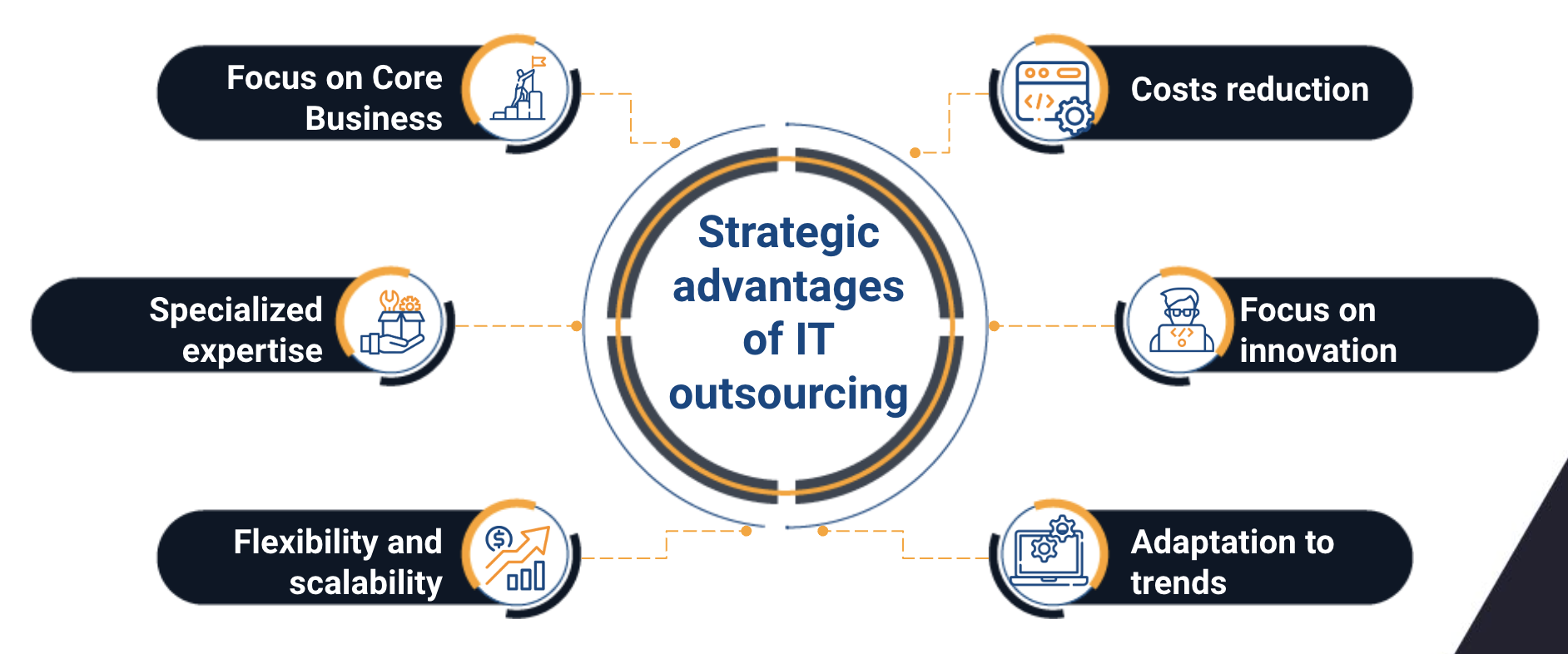
In today's competitive business landscape, where innovation and efficiency are essential for success, IT outsourcing has become a key strategy for many organizations. IT outsourcing involves contracting information technology services, such as software development, network management, technical support and more, from specialized third-party providers.
This practice offers a series of strategic advantages that can boost the growth and competitiveness of companies in today's market, which we will talk about in this article.

Strategic advantages of IT outsourcing in the current market
1. Focus on Core Business
One of the main advantages of IT Outsourcing is that it allows companies to focus on their core business, that is, on those main activities that generate value and differentiation in the market. By delegating information technology tasks to external providers, organizations can free up internal resources and focus their efforts on critical areas such as innovation, marketing or customer service.
2. Access to specialized expertise
IT Outsourcing service providers usually have highly specialized teams with experience in various areas of technology. By outsourcing these functions, companies can access specialized talent that would otherwise be expensive or difficult to acquire internally. This allows them to implement the latest technologies and best practices without having to invest in hiring and training internal staff.
“IT outsourcing opens the doors to a vast pool of global talent. Businesses can tap into the expertise of trained professionals around the world, gaining access to specialized skills and knowledge that may be difficult to find locally. This diversity of talent allows companies to raise the quality of their IT services and stay at the forefront of industry trends, promoting innovation and growth”, they indicated in an article in CIO Women magazine.

3. Flexibility and scalability
IT Outsourcing offers companies greater flexibility and scalability based on their changing business needs. Third-party providers can quickly adjust resources and scope of services based on customer requirements, allowing companies to more easily adapt to market fluctuations, changes in demand, and growth opportunities.
“By leveraging an outsourced IT team, startups can scale up or scale down their operations based on their needs. This flexibility is invaluable, particularly in the often unpredictable and rapidly changing startup environment. Startups can scale their operations and production by relying on their outsourcing partners, achieving more with less”, they argued in a Forbes article.
4. Cost reduction
Hiring IT Outsourcing services can help companies significantly reduce their operating costs. By outsourcing information technology functions, organizations can avoid expenses associated with hiring and training staff, acquiring expensive infrastructure and equipment, and maintaining and upgrading systems costs.
Additionally, consumption-based or outcome-based payment models offered by many IT Outsourcing providers can help companies better control their costs and budgets.
5. Focus on innovation
By outsourcing IT functions, companies can free up resources and time to focus on innovation and the development of new products and services. By leaving the management of IT systems and processes in the hands of experts, organizations can focus on finding ways to improve and differentiate themselves in the market, which can result in a significant competitive advantage.
6. Adaptation to technological trends
The technology landscape is constantly evolving, and companies must be prepared to adapt to new trends and emerging technologies to stay competitive. IT Outsourcing providers can help businesses stay up to date with the latest technological innovations and trends, ensuring their IT systems and processes are aligned with market needs and customer expectations.

IT outsourcing contracting models and prices
Time and materials
In this model, the client compensates the supplier according to the time and resources used in the execution of the work, they explained in an article in CIO magazine. Traditionally, this approach has been employed in long-term application development and maintenance contracts. It is appropriate in situations where it is difficult to estimate the scope and specifications of the project or when needs evolve rapidly.
Unit prices / On request
The provider sets a fixed rate for a specific level of service, and the customer pays based on the use of that service. Pay-as-you-go pricing can drive productivity improvements from day one, making it easier to analyze and adjust component costs. However, this requires an accurate estimate of demand volume and a commitment to minimum transaction volumes.

Fixed price
Setting the price at the beginning of the project is common practice. This strategy can be effective when there are clear and stable requirements, objectives and scopes. Fixed prices offer the advantage of cost predictability, which is beneficial for both parties involved.
However, in situations where market prices decrease over time, the fixed price may be inflexible. Additionally, it can present a challenge for the provider, as it must meet agreed service levels at a pre-established price, regardless of the additional resources required to meet those needs.
IT Outsourcing offers a series of strategic advantages that can help companies improve their focus on core business, access specialized expertise, gain flexibility and scalability, reduce costs, foster innovation, improve operational efficiency and adapt to trends. technologies in an increasingly competitive and dynamic business market. By taking advantage of these advantages, organizations can boost their long-term growth and competitiveness.

